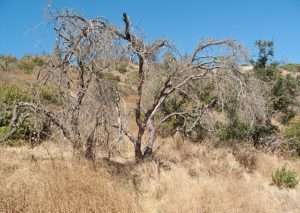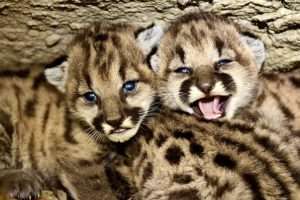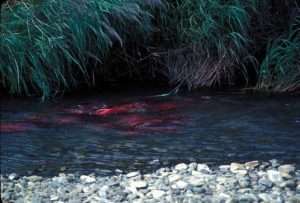 Late last year, people around the world mourned the death of P-22, a geriatric male mountain lion (Puma concolor) who spent the bulk of his life as the lone member of his species in Los Angeles’ Griffith Park. He had been acting unusually aggressively, and wildlife officials captured him to examine whether health issues might be to blame. Ultimately it was found that the kindest thing to do for him was euthanasia, as he was suffering from several conditions, to include injuries from being hit by a car. But his death was not entirely in vain, for he brought the issue of wildlife corridors to greater prominence.
Late last year, people around the world mourned the death of P-22, a geriatric male mountain lion (Puma concolor) who spent the bulk of his life as the lone member of his species in Los Angeles’ Griffith Park. He had been acting unusually aggressively, and wildlife officials captured him to examine whether health issues might be to blame. Ultimately it was found that the kindest thing to do for him was euthanasia, as he was suffering from several conditions, to include injuries from being hit by a car. But his death was not entirely in vain, for he brought the issue of wildlife corridors to greater prominence.
P-22 lived in the heart of a major metropolitan area crisscrossed by many busy highways. Born in the Santa Monica Mountains, he had made the journey across two of these freeways to get to his ultimate territory of Griffith Park. While he was able to migrate safely, many other wild animals have met their deaths on these and other highways across the United States and beyond. And with every highway expansion, new subdivision, and other development, wildlife habitats become more and more fragmented, putting migrating animals in serious danger.
Animals on the Move
Many people are familiar with the twice-yearly migrations of birds, who may fly thousands of miles to reach their breeding grounds in spring, and then return to wintering grounds the following fall. But other animals migrate, too, and there’s usually someone moving from Point A to Point B pretty much any time of the year. Even if not all migrations are so impressively lengthy as bird marathons, even shorter perambulations are still necessary in helping animals find food, territory, mates, and other resources.
P-22’s story was especially poignant because, as far as anyone knows, he never found a mate. Mountain lions are largely solitary creatures that require large territories, and so they generally only meet up when it’s time to create the next generation. Cubs may stay with their mother for their first year or two, but after that they’re each on their own, and must disperse to find their own territories.
 Habitat fragmentation affects all wildlife, but it is especially hard on animals that need larger areas to live. Had P-22’s territory not been physically surrounded by large urban areas, he may have had luck finding a mate at least once or twice in his twelve years of life. In fact, it’s amazing he lived as well as he did in such isolation, since even a small range for a male mountain lion may be at least ten square miles, and Griffith Park is less than seven square miles, with less large prey abundance than in wilder areas.
Habitat fragmentation affects all wildlife, but it is especially hard on animals that need larger areas to live. Had P-22’s territory not been physically surrounded by large urban areas, he may have had luck finding a mate at least once or twice in his twelve years of life. In fact, it’s amazing he lived as well as he did in such isolation, since even a small range for a male mountain lion may be at least ten square miles, and Griffith Park is less than seven square miles, with less large prey abundance than in wilder areas.
It’s in the Genes
But P-22’s story is not unique. All across the United States–and North America, for that matter–migration routes used by mammals and other wildlife have been increasingly fragmented by fences, roads, farms, cities, and other development. If animals cannot successfully and routinely get past artificial barriers, they begin to break up into separate metapopulations. Each metapopulation not only has access to only the resources in its habitat fragment, but it also becomes increasingly genetically isolated as time goes on.
Why is this a problem? Well, the gene pool needs to be stirred up on a regular basis. It’s normal for animals of many species to move around beyond their birthplaces, especially when dispersing to find new territory. This allows animals from different genetic stock to meet up and breed, increasing the overall health and vigor of the species. Isolated metapopulations, on the other hand, each risk becoming trapped in genetic bottlenecks, especially if local populations are shrinking due to other environmental pressures such as continued habitat loss and fragmentation.
 Had P-22 stayed in the Santa Monica Mountains, he could have contributed his genes to the local population. Or imagine if he had headed further eastward, maybe through Joshua Tree National Park, and on into Arizona. He could have gifted his new home an entirely new set of genes and strengthened the local mountain lion population that way.
Had P-22 stayed in the Santa Monica Mountains, he could have contributed his genes to the local population. Or imagine if he had headed further eastward, maybe through Joshua Tree National Park, and on into Arizona. He could have gifted his new home an entirely new set of genes and strengthened the local mountain lion population that way.
But as we humans continue to chew up land, we create more and more barriers for wildlife, leaving them with ever-fewer migration options. One of my biggest messages to people through classes, writing, and more, is that habitat loss is the single biggest cause of species endangerment and extinction. Habitat fragmentation speeds up that process of endangerment, because not only are habitats shrinking but it’s becoming increasingly difficult for species to move out of a too-small habitat to a better option.
A Case for Wildlife Corridors
This is where wildlife corridors come in. In addition to creating and restoring more habitat (and protecting what remains, too), we also need to make sure that the various habitats are connected to each other. That can be a challenge in a place like Los Angeles that is so heavily developed and paved over.
And yet P-22’s death brought about a swell of support for the Wallis Annenberg Wildlife Crossing. This overpass, spanning over 200 feet in length, will allow wildlife a safe way to cross the ten lanes of Highway 101–one of the highways that P-22 had to cross to reach Griffith Park. Native plants will make the overpass more appealing to wildlife, and create small pockets of habitat for both migrating and resident animals. It’s just one step in reconnecting the Santa Monica Mountains to the Simi Hills to the northeast. And it will make a huge difference to the wildlife in both of these havens.
 But we can’t stop there. One high-profile wildlife corridor isn’t enough. We need more overpasses and underpasses that allow migrating terrestrial wildlife to move around safely. We must build more and better culverts and restore natural waterways that allow migrating fish like salmon to migrate to breeding and feeding grounds. Even birds need help, whether through establishing more pockets of habitat along ancestral flyways, or reducing confusion, injury, and death caused by windows and artificial lights.
But we can’t stop there. One high-profile wildlife corridor isn’t enough. We need more overpasses and underpasses that allow migrating terrestrial wildlife to move around safely. We must build more and better culverts and restore natural waterways that allow migrating fish like salmon to migrate to breeding and feeding grounds. Even birds need help, whether through establishing more pockets of habitat along ancestral flyways, or reducing confusion, injury, and death caused by windows and artificial lights.
Edward O. Wilson posited that we need to set aside fully fifty percent of the planet’s land for wildlife if we are to preserve biodiversity. Other scientists and experts add nuance, saying that we can’t simply make half the Earth into isolated wildlife spaces (mostly in poor-quality habitat we don’t want anyway.) I’m rather fond of Douglas Tallamy’s concept of Homegrown National Park, which sees this massive habitat restoration project not just as large empty spaces here and there, but also the wildlife corridors needed to connect them. That includes in urban and other developed areas, and he invites everyone to create microhabitats in their yards or on their balconies. Not everyone can give a mountain lion safe passage, but providing a pathway for smaller animals like migrating birds and pollinating insects is every bit as important.
I am optimistic that as we continue to remove dams that completely change river ecosystems, create an increasing number of land-based wildlife corridors, and keep educating people about the importance of habitat restoration and preservation we will see an improvement in biodiversity in surrounding areas. Yes, things may look dire at times, but it’s not too late. Whether you are able to put pressure on your elected officials at all levels to support wildlife corridors, volunteer on a project to create one, or simply share this article to spread the word to others, you are a part of making this world better for the many species we share it with.
